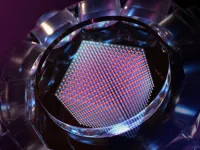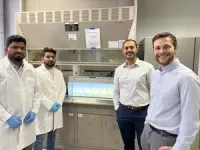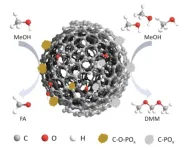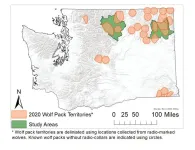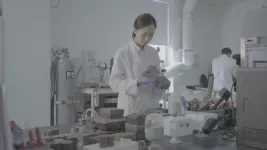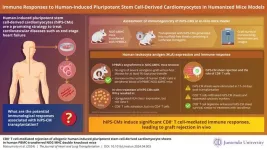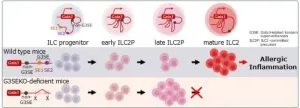(Press-News.org) In a study published online in Nature, a research team led by Prof. PAN Jianwei, Prof. CHEN Yuao, and Prof. YAO Xingcan from the University of Science and Technology of China (USTC) of the Chinese Academy of Sciences has, for the first time, observed the antiferromagnetic phase transition within a large-scale quantum simulator of the fermionic Hubbard model (FHM). This study highlights the advantages of quantum simulation. It marks an important first step towards obtaining the low-temperature phase diagram of the FHM and understanding the role of quantum magnetism in the mechanism of high-temperature superconductivity.
Strongly correlated quantum materials such as high-temperature superconductors are of scientific importance and have potential economic benefits. However, the physical mechanisms underlying these materials remain unclear, posing challenges to their large-scale preparation and application. The FHM, a simplified representation of electron behaviors in a lattice, captures a wide range of physics related to strong correlations, akin to those observed in quantum materials, and is therefore believed to potentially offer solutions to understanding the mechanism of high-temperature superconductivity.
The study of FHM faces challenges. There is no exact analytical solution for this model in two and three dimensions, and due to high computational complexity, even the most advanced numerical methods can explore only limited parameter spaces. Moreover, theoretical studies suggest that even a universal digital quantum computer would struggle to accurately solve this model.
It is widely held that quantum simulation, employing ultracold fermionic atoms in optical lattices, can be the key to mapping out the low-temperature phase diagram of the FHM. To this end, realizing the antiferromagnetic phase transition and reaching the ground state of the FHM at half-filling constitute the foremost steps. Such an achievement would validate two key capabilities of the quantum simulator: the establishment of a large-scale, spatially homogeneous optical lattice for uniform Hubbard parameters, and maintaining a system temperature significantly below Néel temperature, the antiferromagnetic phase transition temperature, both of which are essential for exploring the role of quantum magnetic fluctuations in the mechanism of high-temperature superconductivity.
However, the difficulty in cooling fermionic atoms and inhomogeneity introduced by a standard Gaussian-profile lattice laser have hindered the realization of antiferromagnetic phase transition in previous quantum simulation experiments. To address these challenges, the team, based on their earlier achievements of the preparation and investigation of homogeneous strongly interacting Fermi gases in a box potential (Science, Nature), developed an advanced quantum simulator by combining the generation of a low-temperature homogeneous Fermi gas in a box trap with the demonstration of a flat-top optical lattice with uniform site potentials.
This quantum simulator contains approximately 800,000 lattice sites, about four orders of magnitude larger than current experiments with several dozen sites, and features uniform Hamiltonian parameters with temperatures significantly below the Néel temperature. Leveraging this setup, the team precisely tuned the interaction strength, temperature, and doping concentration to approach their respective critical values, and directly observed conclusive evidence of the antiferromagnetic phase transition, i.e., the power-law divergence of the spin structure factors, with a critical exponent of 1.396 from the Heisenberg universality.
This work advances the understanding of quantum magnetism and lays the foundation for further solving the FHM and obtaining its low-temperature phase diagram. Notably, the experimental results deviating from the half-filling condition have already surpassed the capabilities of current classical computing, demonstrating quantum simulation advantages in addressing key scientific problems.
END
Antiferromagnetic phase transition observed in fermionic Hubbard quantum simulator
2024-07-10
ELSE PRESS RELEASES FROM THIS DATE:
A drug that lowers blood lipids could help treat the world’s most common liver disease
2024-07-10
The University of Barcelona has led a study that suggests using the drug known as pemafibrate to treat liver disease associated with metabolic disorders, the most common liver pathology in the world, which affects one in four people. The drug has long been marketed in Japan for another use: improving blood lipid levels in patients with hyperlipidaemia, a common condition in diabetics. Now, however, it could help address this serious liver disease, which still has no specific treatment.
The study, carried out on laboratory animal models and published in the journal Biomedicine & Pharmacotherapy, was conducted by a team led by Professor Juan ...
Ochsner, AJMC® partner for conference on value-based care on July 25 in New Orleans
2024-07-10
NEW ORLEANS – Ochsner Health’s Healthy State initiative, in partnership with The American Journal of Managed Care, will host a free conference on value-based care from 3:30-7 p.m. on Thursday, July 25 at The Westin New Orleans hotel in Louisiana.
Registration and program details are available here for “Healthy State: Know It, Own It, Live It: Creating a Thriving Louisiana Through Innovation in Value-Based Care.” The event is open to the public, medical professionals, health policy experts and community organizers.
Organized ...
NIH funds consortium to accelerate development of new TB treatments
2024-07-10
A new consortium co-led by Weill Cornell Medicine, has been awarded a five-year, $31 million grant from the National Institutes of Health’s National Institute of Allergy and Infectious Diseases to accelerate the development of faster, more effective treatment regimens for tuberculosis (TB). Investigators at the University of California, San Francisco; Johns Hopkins Medicine; and Vanderbilt University Medical Center comprise the other co-leads.
The Preclinical Design and Clinical Translation ...
Older women more likely to receive heart surgery, die at low quality hospitals
2024-07-10
Women over the age of 65 who require complex heart surgery are more likely than men to receive care at low quality hospitals — where they also die in greater numbers following the procedure, a Michigan Medicine study finds.
The research, published in JAMA Network Open, covered nearly 450,000 Medicare beneficiaries who underwent coronary artery bypass grafting, or heart bypass surgery, between late 2015 and early 2020.
Compared to men, women were 1.26 times more likely to be treated at low quality hospitals, meaning facilities with the highest 30-day mortality rates.
At those low quality hospitals, ...
Nanocarbon catalyst design unlocks new avenue for sustainable fuel additive production
2024-07-10
Vehicle exhaust from fossil fuel combustion constitutes a main source of air pollutants like carbon dioxide and carbon monoxide. To mitigate air pollution, researchers are looking into additive to fuels like dimethoxymethane (DMM). But DMM production brings its own environmental hazards.
In their paper published June 21 in Carbon Future, a Chinese research team demonstrated how a series of phosphorous-modified nanocarbon catalysts could advance green DMM production.
Unique fuel properties of this diesel blend fuel include high oxygen content and chemical stability as well as low toxicity. A blend of DMM and ...
Wolves’ return has had only small impact on deer populations in NE Washington, study shows
2024-07-10
FROM: James Urton
(Note: researcher contact information at the end)
Humans drove wolves to extinction in Washington state around the 1930s. Thanks to conservation efforts, by about 80 years later, wolves had returned — crossing first from the Canadian border into Washington around 2008 and later entering the state from Idaho. Since then, wolf numbers in Washington have been steadily growing, raising questions about what the return of this large predator species means for ecosystems and people alike.
In northeast Washington, where wolves have recovered most successfully, researchers from the University of Washington and the Washington Department ...
Producing ‘space brick’ for moon base using microwave
2024-07-10
The Moon’s recent discovery of energy resources, such as water ice, has refocused interest on its potential as a sustainable hub for space exploration. NASA has also announced the Artemis mission, aiming for long-term human presence on the lunar surface. However, infrastructure expansion, such as lunar base construction plays a vital role.
Yet, transporting construction materials from Earth to the lunar surface via landers incurs a significant cost of 1.2 million USD per kilogram. Weight directly translates to cost, making the transportation of construction materials from Earth to the Moon nearly impossible.
To solve this problem, Korea ...
A simple firmware update completely hides a device’s Bluetooth fingerprint
2024-07-10
A smartphone’s unique Bluetooth fingerprint could be used to track the device’s user–until now. A team of researchers have developed a simple firmware update that can completely hide the Bluetooth fingerprint, eliminating the vulnerability.
The method was developed by a team of researchers at the University of California San Diego. The team discovered the vulnerability caused by Bluetooth fingerprints in a study they presented at the 2022 IEEE Security & Privacy conference. They presented the fix to this vulnerability two years later at the 2024 IEEE Security & Privacy conference. The math behind the update itself is complex but the implementation ...
Immunogenicity of human-induced pluripotent stem cell-derived cardiomyocyte sheets
2024-07-10
Ischemic heart disease stands as a significant global cause of morbidity and mortality. One promising avenue for treatment involves human induced pluripotent stem cell-derived cardiomyocytes (hiPS-CMs). Derived from adult somatic cells such as blood or skin cells, hiPS cells possess the capacity to differentiate into various tissues, including cardiomyocytes. These cells can potentially repair damaged heart tissue, but their clinical application is limited due to concerns about immune rejection. Understanding the immunogenicity of hiPS-CMs is crucial for advancing their ...
Unravelling a mechanism of Group 2 innate lymphoid immune cell development
2024-07-10
Overproduction of Group 2 innate lymphoid cells or ILC2s—a type of white blood cells—can sometimes exacerbate conditions such as bronchial asthma, chronic rhinosinusitis, atopic dermatitis, and organ fibrosis through an exaggerated immune response. Although there are immunomodulatory drugs that can suppress Type 2 helper T (Th2) cells, drugs capable of suppressing ILC2s are currently lacking.
Now, however, in a breakthrough study that could lead to the development of a new therapeutic strategy targeting ILC2s, researchers led by Associate Professor Arifumi Iwata of the Chiba University Hospital, Japan, have identified molecular ...
